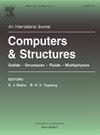On application of the relative entropy concept in reliability assessment of some engineering cable structures
IF 4.4
2区 工程技术
Q1 COMPUTER SCIENCE, INTERDISCIPLINARY APPLICATIONS
引用次数: 0
Abstract
The main research problem studied in this work is an uncertain response and reliability assessment of the spatial cable structures due to the environmental stochasticity as well as material and geometrical imperfections. Some popular cable structures are analyzed for this purpose using the Stochastic Finite Element Method (SFEM) implemented with the use of three different techniques, namely the iterative generalized perturbation method, semi-analytical approach as well as the Monte-Carlo simulation. Uncertainty quantification delivered in this study is based on the series of FEM analyses of both static and dynamic structural problems. They enable the Least Squares Method determination of the structural polynomial responses linking extreme stresses and deformations with several uncorrelated uncertainty sources. Reliability assessment, fundamental in durability and Structural Health Monitoring, is completed using a comparison of the First Order Reliability Method (FORM) with probabilistic distance formulated by Bhattacharyya. Input uncertainties are assumed to be Gaussian according to the Maximum Entropy Principle. They have specific expected values following engineering design demands or the provisions of designing codes, whereas their standard deviations do not exceed the 10% level. The methods presented and the results obtained in this study may serve for further reliability analyses of large-scale civil engineering structures completed with both steel cables and also reinforced concrete plates like suspended bridges, for instance.
论相对熵概念在某些工程电缆结构可靠性评估中的应用
这项工作研究的主要问题是由于环境随机性以及材料和几何缺陷造成的空间缆索结构的不确定响应和可靠性评估。为此,采用随机有限元法(SFEM)对一些常用的电缆结构进行了分析,并使用了三种不同的技术,即迭代广义扰动法、半解析法和蒙特卡罗模拟法。本研究中的不确定性量化基于对静态和动态结构问题的一系列有限元分析。这些分析采用最小二乘法确定结构的多项式响应,将极端应力和变形与几个不相关的不确定性源联系起来。可靠性评估是耐久性和结构健康监测的基础,采用一阶可靠性方法 (FORM) 与 Bhattacharyya 提出的概率距离进行比较。根据最大熵原理,输入的不确定性被假定为高斯。根据工程设计要求或设计规范的规定,它们具有特定的预期值,而其标准偏差不超过 10%。本研究提出的方法和获得的结果可用于进一步分析由钢缆和钢筋混凝土板(如悬索桥)建成的大型土木工程结构的可靠性。
本文章由计算机程序翻译,如有差异,请以英文原文为准。
求助全文
约1分钟内获得全文
求助全文
来源期刊

Computers & Structures
工程技术-工程:土木
CiteScore
8.80
自引率
6.40%
发文量
122
审稿时长
33 days
期刊介绍:
Computers & Structures publishes advances in the development and use of computational methods for the solution of problems in engineering and the sciences. The range of appropriate contributions is wide, and includes papers on establishing appropriate mathematical models and their numerical solution in all areas of mechanics. The journal also includes articles that present a substantial review of a field in the topics of the journal.
 求助内容:
求助内容: 应助结果提醒方式:
应助结果提醒方式:


